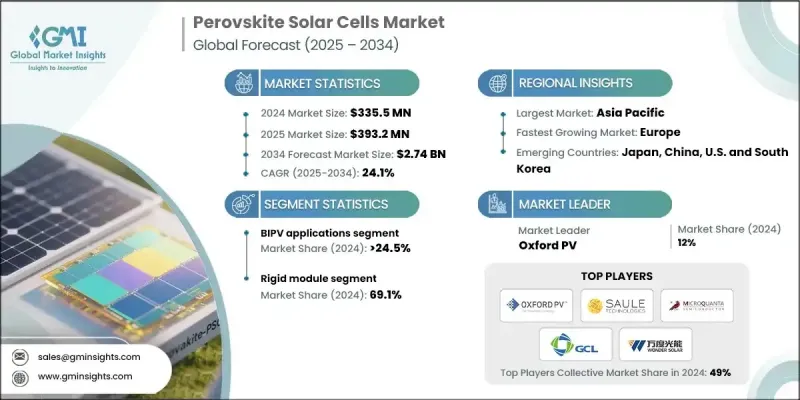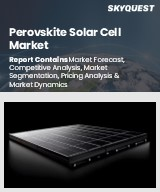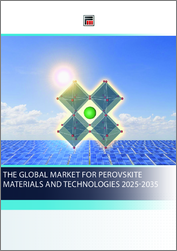
|
시장보고서
상품코드
1871075
페로브스카이트 태양전지 시장 기회, 성장 요인, 업계 동향 분석 및 예측(2025-2034년)Perovskite Solar Cells Market Opportunity, Growth Drivers, Industry Trend Analysis, and Forecast 2025 - 2034 |
||||||
세계의 페로브스카이트 태양전지 시장은 2024년에 3억 3,550만 달러로 평가되었으며, 2034년까지 연평균 복합 성장률(CAGR) 24.1%를 나타내 27억 4,000만 달러에 이를 것으로 예측됩니다.

페로브스카이트 태양전지는 고효율, 낮은 제조 비용, 우수한 설계 유연성을 제공하는 최첨단 태양광 발전(PV) 기술로 부상하고 있습니다. 이들 셀은 페로브스카이트 구조의 화합물을 활성 광 흡수 재료로서 이용하여 태양에너지를 효율적으로 전기로 변환할 수 있습니다. 스핀 코팅, 블레이드 코팅, 잉크젯 인쇄와 같은 저온 용액 기반 제조 기술을 통해 생산이 가능하므로 기존 실리콘계 태양전지 기술에 비해 제조 비용을 대폭 절감할 수 있습니다. 전력 변환 효율과 확장성의 지속적인 향상, 그리고 재료 불순물이 존재하더라도 성능을 유지할 수 있는 페로브스카이트 재료의 특성으로 인해 시장은 강한 성장세를 얻고 있습니다. 롤 투 롤 생산을 포함한 대규모 제조 기법과의 호환성은 상업적 실현 가능성을 더욱 높여줍니다. 건축물, 차량, 휴대기기에 태양광 기술의 통합에 대한 관심 증가도 수요를 견인하고 있습니다. 보다 높은 에너지 출력 달성, 제조 공정 간소화, 다양한 용도에의 적응성을 갖춘 페로브스카이트 태양전지는 향후 10년간 재생에너지의 정세를 재구축할 것으로 전망됩니다.
| 시장 범위 | |
|---|---|
| 시작 연도 | 2024년 |
| 예측 연도 | 2025-2034년 |
| 시작 금액 | 3억 3,550만 달러 |
| 예측 금액 | 27억 4,000만 달러 |
| CAGR | 24.1% |
건축물 일체형 태양광 발전(BIPV) 부문은 2024년에 35.8%의 점유율을 차지했으며, 2034년까지 연평균 복합 성장률(CAGR) 24.5%를 나타낼 전망입니다. 이 성장은 기능성과 디자인의 유연성을 결합한 에너지 절약 건축자재에 대한 수요가 증가함에 따라 지원됩니다. 이 셀은 건축가와 개발자에게 다양한 색상, 투명성, 경량 구성 등의 미적 이점을 제공하여 건물의 외관과 지붕에 원활하게 통합 할 수 있습니다. 그 다기능은 특히 에너지 의식이 높은 지역에서 상업용 및 주택 건설 프로젝트 전반에 걸친 채택 확대에 기여하고 재생에너지 전환의 역할을 강화하고 있습니다.
유연한 모듈 기술 부문은 2024년에 30.9%의 점유율을 차지했으며, 2034년까지 연평균 복합 성장률(CAGR) 24.5%를 나타낼 것으로 예측됩니다. 이 모듈은 플라스틱이나 금속박제의 얇은 경량 기판을 활용하고 있어, 곡면·가동·중량 제한이 있는 용도에 최적입니다. 롤 투 롤 생산 기술을 통해 확장 가능한 유연한 소재로 20% 이상의 전력 변환 효율을 달성할 수 있다는 점이 제조업체와 최종 사용자들 사이에서 큰 관심을 모으고 있습니다. 그 적응성과 도입의 용이성은 특히 휴대용 에너지 장비 및 운송 응용 분야에서 차세대 태양광 시스템에 대한 유망한 해결책이 되었습니다.
유럽의 페로브스카이트 태양전지 시장은 강력한 정부 시책, 첨단 연구 프로그램, 야심찬 신재생에너지 정책에 힘입어 2034년까지 8억 달러 규모에 이를 것으로 예측됩니다. 이 지역은 선구적인 연구기관과 산업계의 연계를 배경으로 페로브스카이트 태양전지 기술의 상업화에 있어 세계를 선도하고 있습니다. 유럽 대학, 국립 연구소 및 비공개 회사의 공동 노력으로 기술 진보가 급속히 진행되고 있으며 유럽의 페로브스카이트 기술 혁신의 주도적 입장이 유지되고 있습니다. 페로브스카이트 셀을 다양한 신재생에너지 용도에 통합하는 노력이 강화됨에 따라 유럽은 제품 개발과 시장 확대의 중심 거점으로서의 지위를 확립하고 있습니다.
세계의 페로브스카이트 태양전지 시장에 참여하는 주요 기업은 Oxford Photovoltaics, Saule Technologies, Swift Solar, Microquanta Semiconductor, Frontier Energy Solutions, Energy Materials Corp., Heiking PV Technology, Dyenamo AB, Caelux, Fraunhofer ISE, FUJIFILM Wako Pure Chemical Corporation, Li Yuan New Energy Technology, Alfa Aesar, G24 Power Ltd., Hunt Perovskite Technologies, GCL Suzhou Nanotechnology, CubicPV, FrontMaterials Co. Ltd., Hubei Wonder Solar, Sekisui Chemical 등입니다. 페로브스카이트 태양전지 업계의 주요 기업은 존재감을 강화하기 위해 혁신, 생산 규모 확대, 재료 최적화에 의한 제품 효율 향상에 주력하고 있습니다. 각 회사는 실제 사용 환경에서 안정성, 수명 및 성능을 향상시키기 위해 연구 개발에 많은 투자를하고 있습니다. 상용 전개를 가속시키기 위해 연구기관과 제조업체 간의 전략적 제휴가 구축되고 있습니다.
목차
제1장 조사 방법과 범위
제2장 주요 요약
제3장 업계 인사이트
- 업계의 생태계
- 규제 상황
- 업계에 미치는 영향요인
- 성장 촉진요인
- 업계의 잠재적 위험 및 과제
- 성장 가능성 분석
- Porter's Five Forces 분석
- PESTEL 분석
제4장 경쟁 구도
- 서론
- 기업의 시장 점유율 분석 : 지역별
- 북미
- 유럽
- 아시아태평양
- 세계 기타 지역
- 전략적 대시보드
- 전략적 이니셔티브
- 기업 벤치마킹
- 파괴적 혁신과 기술의 정세
제5장 시장 규모와 예측 : 유형별(2021-2034년)
- 주요 동향
- 경질
- 유연
제6장 시장 규모와 예측 : 용도별(2021-2034년)
- 주요 동향
- BIPV
- 발전
- 방위 및 항공우주
- 운송
- 소비자용 전자 기기
제7장 시장 규모와 예측 : 최종 용도별(2021-2034년)
- 주요 동향
- 주택용
- 상업 및 산업
- 유틸리티
제8장 시장 규모와 예측 : 지역별(2021-2034년)
- 주요 동향
- 북미
- 미국
- 캐나다
- 멕시코
- 유럽
- 독일
- 프랑스
- 이탈리아
- 영국
- 폴란드
- 아시아태평양
- 중국
- 인도
- 일본
- 한국
- 호주
- 세계 기타 지역
제9장 기업 프로파일
- Alfa Aesar
- Caelux
- CubicPV
- Dyenamo AB
- Energy Materials Corp.
- Fraunhofer ISE
- Frontier Energy Solutions
- FrontMaterials Co. Ltd.
- FUJIFILM Wako Pure Chemical Corporation
- G24 Power Ltd.
- GCL Suzhou Nanotechnology
- Heiking PV Technology
- Hubei Wonder Solar
- Hunt Perovskite Technologies
- Li Yuan New Energy Technology
- Microquanta Semiconductor
- Oxfords Photovoltaics
- Saule Technologies
- Sekisui Chemical
- Swift Solar
The Global Perovskite Solar Cells Market was valued at USD 335.5 million in 2024 and is estimated to grow at a CAGR of 24.1% to reach USD 2.74 Billion by 2034.

Perovskite solar cells are emerging as a cutting-edge photovoltaic (PV) technology that offers high efficiency, low production cost, and exceptional flexibility in design. These cells utilize a perovskite-structured compound as the active light-absorbing material, capable of efficiently converting solar energy into electricity. Their ability to be produced using low-temperature, solution-based fabrication techniques such as spin-coating, blade-coating, and inkjet printing significantly reduces manufacturing expenses when compared to traditional silicon-based solar technologies. The market is gaining strong momentum owing to continuous advancements in power conversion efficiency and scalability, alongside the ability of perovskite materials to maintain performance even with material impurities. The compatibility of these cells with large-scale manufacturing approaches, including roll-to-roll production, is further improving commercial viability. Increasing interest in integrating solar technologies into buildings, vehicles, and portable devices is also driving demand. With their capability to achieve higher energy output, reduced production complexity, and adaptability to diverse applications, perovskite solar cells are set to reshape the renewable energy landscape over the next decade.
| Market Scope | |
|---|---|
| Start Year | 2024 |
| Forecast Year | 2025-2034 |
| Start Value | $335.5 Million |
| Forecast Value | $2.74 Billion |
| CAGR | 24.1% |
The building-integrated photovoltaic (BIPV) segment held 35.8% in 2024, growing at a CAGR of 24.5% through 2034. This growth is supported by the rising preference for energy-efficient building materials that combine functionality and design flexibility. These cells provide architects and developers with aesthetic benefits such as color versatility, transparency options, and lightweight configurations, enabling smooth integration into building facades and roofs. Their multifunctional features are contributing to increased adoption across commercial and residential construction projects, particularly in energy-conscious regions, enhancing their role within the renewable energy transition.
The flexible module technology segment held 30.9% share in 2024 and is projected to grow at a CAGR of 24.5% through 2034. These modules leverage thin, lightweight substrates made of plastic or metal foils, making them ideal for curved, mobile, and weight-sensitive applications. The ability to achieve power conversion efficiencies surpassing 20% on scalable, flexible materials through roll-to-roll production is driving significant interest among manufacturers and end users. Their adaptability and ease of deployment make them a promising solution for next-generation solar systems, particularly in portable energy devices and transport applications.
Europe Perovskite Solar Cells Market will reach USD 800 million by 2034, supported by robust government initiatives, advanced research programs, and ambitious renewable energy policies. The region continues to lead the global commercialization of perovskite solar technologies, backed by pioneering research institutions and industry collaborations. The combined efforts of European universities, national laboratories, and private companies are ensuring rapid technological progress and maintaining Europe's leadership in perovskite innovation. The strong focus on integrating perovskite cells into various renewable applications is positioning Europe as a central hub for product development and market expansion.
Prominent companies participating in the Global Perovskite Solar Cells Market include Oxford Photovoltaics, Saule Technologies, Swift Solar, Microquanta Semiconductor, Frontier Energy Solutions, Energy Materials Corp., Heiking PV Technology, Dyenamo AB, Caelux, Fraunhofer ISE, FUJIFILM Wako Pure Chemical Corporation, Li Yuan New Energy Technology, Alfa Aesar, G24 Power Ltd., Hunt Perovskite Technologies, GCL Suzhou Nanotechnology, CubicPV, FrontMaterials Co. Ltd., Hubei Wonder Solar, and Sekisui Chemical. To reinforce their presence, key players in the perovskite solar cells industry are focusing on innovation, scaling production, and enhancing product efficiency through material optimization. Companies are investing heavily in research and development to improve stability, lifespan, and performance under real-world conditions. Strategic partnerships between research institutions and manufacturers are being established to accelerate commercial deployment.
Table of Contents
Chapter 1 Methodology & Scope
- 1.1 Research design
- 1.1.1 Research approach
- 1.1.2 Data collection methods
- 1.1.3 Base estimates and calculations
- 1.1.4 Base year calculation
- 1.1.5 Key trends for market estimates
- 1.2 Forecast model
- 1.3 Primary research & validation
- 1.3.1 Primary sources
- 1.4 Data mining sources
- 1.5 Market definitions
Chapter 2 Executive Summary
- 2.1 Industry 3600 synopsis, 2021 - 2034
- 2.2 Business trends
- 2.3 Type trends
- 2.4 Application trends
- 2.5 End Use trends
- 2.6 Regional trends
Chapter 3 Industry Insights
- 3.1 Industry ecosystem
- 3.2 Regulatory landscape
- 3.3 Industry impact forces
- 3.3.1 Growth drivers
- 3.3.2 Industry pitfalls & challenges
- 3.4 Growth potential analysis
- 3.5 Porter's analysis
- 3.5.1 Bargaining power of suppliers
- 3.5.2 Bargaining power of buyers
- 3.5.3 Threat of new entrants
- 3.5.4 Threat of substitutes
- 3.6 PESTEL analysis
Chapter 4 Competitive landscape, 2025
- 4.1 Introduction
- 4.2 Company market share analysis, by region, 2024
- 4.2.1 North America
- 4.2.2 Europe
- 4.2.3 Asia Pacific
- 4.2.4 Rest of world
- 4.3 Strategic dashboard
- 4.4 Strategic initiatives
- 4.5 Company benchmarking
- 4.6 Innovation & technology landscape
Chapter 5 Market Size and Forecast, By Type, 2021 - 2034 (USD Million)
- 5.1 Key trends
- 5.2 Rigid
- 5.3 Flexible
Chapter 6 Market Size and Forecast, By Application, 2021 - 2034 (USD Million)
- 6.1 Key trends
- 6.2 BIPV
- 6.3 Power generation
- 6.4 Defense & aerospace
- 6.5 Transportation
- 6.6 Consumer electronics
Chapter 7 Market Size and Forecast, By End Use, 2021 - 2034 (USD Million)
- 7.1 Key trends
- 7.2 Residential
- 7.3 Commercial & industrial
- 7.4 Utility
Chapter 8 Market Size and Forecast, By Region, 2021 - 2034 (USD Million)
- 8.1 Key trends
- 8.2 North America
- 8.2.1 U.S
- 8.2.2 Canada
- 8.2.3 Mexico
- 8.3 Europe
- 8.3.1 Germany
- 8.3.2 France
- 8.3.3 Italy
- 8.3.4 UK
- 8.3.5 Poland
- 8.4 Asia Pacific
- 8.4.1 China
- 8.4.2 India
- 8.4.3 Japan
- 8.4.4 South Korea
- 8.4.5 Australia
- 8.5 Rest of World
Chapter 9 Company Profiles
- 9.1 Alfa Aesar
- 9.2 Caelux
- 9.3 CubicPV
- 9.4 Dyenamo AB
- 9.5 Energy Materials Corp.
- 9.6 Fraunhofer ISE
- 9.7 Frontier Energy Solutions
- 9.8 FrontMaterials Co. Ltd.
- 9.9 FUJIFILM Wako Pure Chemical Corporation
- 9.10 G24 Power Ltd.
- 9.11 GCL Suzhou Nanotechnology
- 9.12 Heiking PV Technology
- 9.13 Hubei Wonder Solar
- 9.14 Hunt Perovskite Technologies
- 9.15 Li Yuan New Energy Technology
- 9.16 Microquanta Semiconductor
- 9.17 Oxfords Photovoltaics
- 9.18 Saule Technologies
- 9.19 Sekisui Chemical
- 9.20 Swift Solar



















